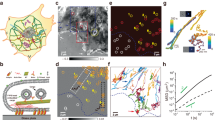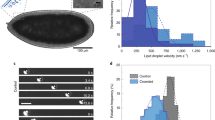Abstract
The advantage of precision in biological processes is obvious; however, in many cases, deviations from the faithful mechanisms occur. Here, we discuss how in-built operating imperfections in transport systems can actually benefit a cell.
This is a preview of subscription content, access via your institution
Access options
Subscribe to this journal
Receive 12 print issues and online access
$189.00 per year
only $15.75 per issue
Buy this article
- Purchase on Springer Link
- Instant access to full article PDF
Prices may be subject to local taxes which are calculated during checkout



Similar content being viewed by others
References
Hancock, J. M. The contribution of slippage-like processes to genome evolution. J. Mol. Evol. 41, 1038–1047 (1995).
Karlstrom, A. et al. Using antibody catalysis to study the outcome of multiple evolutionary trials of a chemical task. Proc. Natl Acad. Sci. USA 97, 3878–3883 (2000).
Hughes, J. F. & Coffin, J. M. Evidence for genomic rearrangements mediated by human endogenous retroviruses during primate evolution. Nature Genet. 29, 487–489 (2001).
Barry, J. D. & McCulloch, R. Antigenic variation in trypanosomes: enhanced phenotypic variation in a eukaryotic parasite. Adv. Parasitol. 49, 1–70 (2001).
Jordan, P. et al. Three-dimensional structure of cyanobacterial photosystem I at 2.5 Å resolution. Nature 411, 909–917 (2001).
Pietrobon, D., Zoratti, M., Azzone, G. F. & Caplan, S. R. Intrinsic uncoupling of mitochondrial proton pumps. 2. Modeling studies. Biochemistry 25, 767–775 (1986).
Caplan, S. R. in The Ion Pumps, Structure, Function and Regulation (ed. Stein, W. D.) 377–386 (Alan R. Liss, New York, 1988).
Nelson, N. & Harvey, W. R. Vacuolar and plasma membrane V-ATPases. Phys. Rev. 79, 361–385 (1999).
Senior, A. E., Nadanaciva, S. & Weber, J. The molecular mechanism of ATP synthesis by F1F0-ATP synthase. Biochim. Biophys. Acta 1553, 188–211 (2002).
Leslie, A. G. & Walker, J. E. Structural model of F1-ATPase and the implications for rotary catalysis. Phil. Trans. R. Soc. Lond. B Biol. Sci. 355, 465–471 (2000).
Hirata, T., Nakamura, N., Omote, H., Wada, Y. & Futai, M. Regulation and reversibility of vacuolar H(+)-ATPase. J. Biol. Chem. 275, 386–389 (2000).
Abrahams, J. P., Leslie, A. G. W., Lutter, R. & Walker, J. E. Structure at 2.8Å resolution of F1-ATPase from bovine heart mitochondria. Nature 370, 621–628 (1994).
Junge, W., Lill, H. & Engelbrecht, S. ATP synthase: an electrochemical transducer with rotatory mechanics. Trends Biochem. Sci. 22, 420–423 (1997).
Junge, W. et al. Inter-subunit rotation and elastic power transmission in F0F1-ATPase. FEBS Lett. 504,152–160 (2001).
Yoshida, M., Muneyuki, E. & Hisabori, T. ATP synthase — a marvellous rotary engine of the cell. Nature Rev. Mol. Cell Biol. 2, 669–677 (2001).
Cherepanov, D. A. & Junge, W. Viscoelastic dynamics of actin filaments coupled to rotary F-ATPase: curvature as an indicator of the torque. Biophys. J. 81, 1234–1244 (2001).
Sambongi, Y. et al. Mechanical rotation of the c subunit oligomer in ATP synthase (F0F1): direct observation. Science 286, 1687–1688 (1999).
Stahlberg, H. et al. Bacterial Na(+)-ATP synthase has an undecameric rotor. EMBO Rep. 2, 229–233 (2001).
Seelert, H. et al. Structural biology. Proton-powered turbine of a plant motor. Nature 405, 418–419 (2000).
Stock, D., Leslie, A. G. & Walker, J. E. Molecular architecture of the rotary motor in ATP synthase. Science 286, 1700–1705 (1999).
Schonfeld, M. & Neumann, J. Proton conductance of the thylakoid membrane: modulation by light. FEBS Lett. 73, 51–54 (1977).
Braun, G., Evron, Y., Malkin, S. & Avron, M. Proton flow through the ATP synthase in chloroplasts regulates the distribution of light energy between PS I and PS II. FEBS Lett. 280, 57–60 (1991).
Groth, G. & Junge, W. Proton slip of the chloroplast ATPase: its nucleotide dependence, energetic threshold, and relation to an alternating site mechanism of catalysis. Biochemistry 32, 8103–8111 (1993).
Hinkle, P. C., Kumar, M. A., Resetar, A. & Harris, D. L. Mechanistic stoichiometry of mitochondrial oxidative phosphorylation. Biochemistry 30, 3576–3582 (1991).
Feniouk, B. A., Cherepanov, D. A., Junge, W. & Mulkidjanian, A. Y. ATP-synthase of Rhodobacter capsulatus: coupling of proton flow through F0 to reactions in F1 under the ATP synthesis and slip conditions. FEBS Lett. 445, 409–414 (1999).
Nelson, N. Evolution of organellar proton-ATPases. Biochim. Biophys. Acta 1100, 109–124 (1992).
Moriyama, Y. & Nelson, N. in The Ion Pumps, Structure, Function and Regulation (ed. Stein, W. D.) 387–394 (Alan R. Liss, New York, 1988).
Grabe, M., Wang, H. & Oster, G. The mechanochemistry of V-ATPase proton pumps. Biophys. J. 78, 2798–2813 (2000).
Arechaga, I. & Jones, P. C. The rotor in the membrane of the ATP synthase and relatives. FEBS Lett. 494, 1–5 (2001).
Müller, M., Irkens-Kiesecker, U., Rubinstein, B. & Taiz, L. On the mechanism of hyperacidification in lemon. Comparison of the vacuolar H+-ATPase activities of fruits and epicotyls. J. Biol. Chem. 271, 1916–1924 (1996).
Müller, M. L., Irkens-Kiesecker, U., Kramer, D. & Taiz, L. Purification and reconstitution of the vacuolar H+-ATPases from lemon fruits and epicotyls. J. Biol. Chem. 272, 12762–12770 (1997).
Müller, M. L., Jensen, M. & Taiz, L. The vacuolar H+-ATPase of lemon fruits is regulated by variable H+/ATP coupling and slip. J. Biol. Chem. 274, 10706–10716 (1999).
Uyama, T., Moriyama, Y., Futai, M. & Michibata, H. Immunological detection of a vacuolar-type H(+)-ATPase in vanadocytes of the ascidian Ascidia sydneiensis samea. J. Exp. Zool. 270, 148–154 (1994).
Bruns, D., Engert, F. & Lux, H. D. A fast activating presynaptic reuptake current during serotonergic transmission in identified neurons of Hirudo. Neuron 10, 559–572 (1993).
Petersen, C. I. & DeFelice, L. J. Ionic interactions in the Drosophila serotonin transporter identify it as a serotonin channel. Nature Neurosci. 2, 605–610 (1999).
Su, A., Mager, S., Mayo, S. L. & Lester, H. A. A multi-substrate single-file model for ion-coupled transporters. Biophys. J. 70, 762–777 (1996).
Nelson, N. The family of Na+/Cl− neurotransmitter transporters. J. Neurochem. 71, 1785–1803 (1998).
Cao, Y., Mager, S. & Lester, H. A. H+ permeation and pH regulation at a mammalian serotonin transporter. J. Neurosci. 17, 2257–2266 (1997).
Kanner, B. Glutamate transporters from brain — a novel neurotransmitter transporter family. FEBS Lett. 325, 95–99 (1993).
Zerangue, N. & Kavanaugh, M. P. Flux coupling in a neuronal glutamate transporter. Nature 383, 634–637 (1996).
Mager, S. et al. Conducting states of a mammalian serotonin transporter. Neuron 12, 845–859 (1994).
Sonders, M. S. & Amara, S. G. Channels in transporters. Curr. Opin. Neurobiol. 6, 294–302 (1996).
Lester, H. A., Cao, Y. & Mager, S. Listening to neurotransmitter transporters. Neuron 17, 807–810 (1996).
DeFelice, L. J. & Blakely, R. D. Pore models for transporters? Biophys. J. 70, 579–580 (1996).
Sonders, M. S., Zhu, S. J., Zahniser, N. R., Kavanaugh, M. P. & Amara, S. G. Multiple ionic conductances of the human dopamine transporter: the actions of dopamine and psychostimulants. J. Neurosci. 17, 960–974 (1997).
Galli, A., Blakely, R. D. & DeFelice, L. J. Norepinephrine transporters have channel modes of conduction. Proc. Natl Acad. Sci. USA 93, 8671–8676 (1996).
Galli, A., Petersen, C. I., deBlaquiere, M., Blakely, R. D. & DeFelice, L. J. Drosophila serotonin transporters have voltage-dependent uptake coupled to a serotonin-gated ion channel. J. Neurosci. 17, 3401–3411 (1997).
Kavanaugh, M. P. Neurotransmitter transport: models in flux. Proc. Natl Acad. Sci. USA 95, 12737–12738 (1998).
Fairman, W. A. & Amara, S. G. Functional diversity of excitatory amino acid transporters: ion channel and transport modes. Am. J. Physiol. 277, F481–F486 (1999).
Otis, T. S. & Kavanaugh, M. P. Isolation of current components and partial reaction cycles in the glial glutamate transporter EAAT2. J. Neurosci. 20, 2749–2757 (2000).
Wadiche, J. I. & Kavanaugh, M. P. Macroscopic and microscopic properties of a cloned glutamate transporter/chloride channel. J. Neurosci. 18, 7650–7661 (1998).
MacAulay, N. et al. Engineered Zn(2+) switches in the γ-aminobutyric acid (GABA) transporter-1. Differential effects on GABA uptake and currents. J. Biol. Chem. 276, 40476–40485 (2001).
Mager, S. et al. Ion binding and permeation at the GABA transporter GAT1. J. Neurosci. 16, 5405–5414 (1996).
Ni, Y. G. et al. A lithium-induced conformational change in serotonin transporter alters cocaine binding, ion conductance, and reactivity of Cys-109. J. Biol. Chem. 276, 30942–30947 (2001).
Dix, D. R., Bridgham, J. T., Broderius, M. A., Byersdorfer, C. A. & Eide, D. J. The FET4 gene encodes the low affinity Fe(II) transport protein of Saccharomyces cerevisiae. J. Biol. Chem. 269, 26092–26099 (1994).
Supek, F., Supekova, L., Nelson, H. & Nelson, N. A yeast manganese transporter related to the macrophage protein involved in conferring resistance to mycobacteria. Proc. Natl Acad. Sci. USA 93, 5105–5110 (1996).
Supek, F., Supekova, L., Nelson, H. & Nelson, N. Function of metal-ion homeostasis in cell division cycle, mitochondrial protein processing, sensitivity to mycobacterial infection and brain functions. J. Exp. Biol. 200, 321–330 (1997).
Liu, X. F., Supek, F., Nelson, N. & Culotta, V. C. Negative control of heavy metal uptake by the Saccharomyces cerevisiae BSD2 gene. J. Biol. Chem. 272, 11763–11769 (1997).
Orgad, S., Nelson, H., Segal, D. & Nelson, N. Metal ions suppress the abnormal taste behavior of the Drosophila mutant malvolio. J. Exp. Biol. 201, 115–120 (1998).
Eide, D. J. The molecular biology of metal ion transport in Saccharomyces cerevisiae. Annu. Rev. Nutr. 18, 441–469 (1998).
Radisky, D. C. & Kaplan, J. Regulation of transition metal transport across the yeast plasma membrane. J. Biol. Chem. 274, 4481–4484 (1999).
Rae, T. D., Schmidt, P. J., Pufahl, R. A., Culotta, V. C. & O'Halloran, T. V. Undetectable intracellular free copper: the requirement of a copper chaperone for superoxide dismutase. Science 284, 805–808 (1999).
Nelson, N. Metal-ion transporters and homeostasis. EMBO J. 18, 4361–4371 (1999).
Gunshin, H. et al. Cloning and characterization of a mammalian proton-coupled metal-ion transporter. Nature 388, 482–488 (1997).
Chen, X.-Z. et al. Yeast SMF1 mediates H-coupled iron uptake with concomitant uncoupled cation currents. J. Biol. Chem. 274, 35089–35094 (1999).
Sacher, A., Cohen, A. & Nelson, N. Properties of the mammalian and yeast metal-ion transporters DCT1 and Smf1p expressed in Xenopus oocytes. J. Exp. Biol. 204, 1053–1061 (2001).
Fleming, M. D. et al. Nramp2 is mutated in the anemic Belgrade (b) rat: evidence of a role for Nramp2 in endosomal iron transport. Proc. Natl Acad. Sci. USA 95, 1148–1153 (1998).
Kaback, H. R., Sahin-Toth, M. & Weinglass, A. B. The kamikaze approach to membrane transport. Nature Rev. Mol. Cell Biol. 2, 610–620 (2001).
van Dam, K. Regulation and control of energy coupling at the cellular level. Biochim. Biophys. Acta 1187, 129–131 (1994).
Schuster, S. & Westerhoff, H. V. Modular control analysis of slipping enzymes. Biosystems 49, 1–15 (1999).
Acknowledgements
This work was supported by a grant from the United States–Israel Binational Scientific Foundation.
Author information
Authors and Affiliations
Corresponding author
Related links
Rights and permissions
About this article
Cite this article
Nelson, N., Sacher, A. & Nelson, H. The significance of molecular slips in transport systems. Nat Rev Mol Cell Biol 3, 876–881 (2002). https://doi.org/10.1038/nrm955
Issue Date:
DOI: https://doi.org/10.1038/nrm955
This article is cited by
-
Molecular physiology of EAAT anion channels
Pflügers Archiv - European Journal of Physiology (2016)
-
Amino acid transporter B0AT1 (slc6a19) and ancillary protein: impact on function
Pflügers Archiv - European Journal of Physiology (2016)
-
GABA transporter lysine 448: a key residue for tricyclic antidepressants interaction
Cellular and Molecular Life Sciences (2009)
-
Mechanism and Putative Structure of B0-like Neutral Amino Acid Transporters
Journal of Membrane Biology (2006)
-
Limitations on microalgal growth at very low photon fluence rates: the role of energy slippage
Photosynthesis Research (2006)



